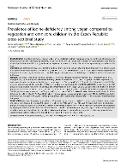| dc.contributor.author | Světnička, Martin | |
| dc.contributor.author | Heniková, Marina | |
| dc.contributor.author | Selinger, Eliška | |
| dc.contributor.author | Ouřadová, Anna | |
| dc.contributor.author | Potočková, Jana | |
| dc.contributor.author | Kühn, Tilman | |
| dc.contributor.author | Gojda, Jan | |
| dc.contributor.author | El-Lababidi, Eva | |
| dc.date.accessioned | 2023-12-29T11:40:37Z | |
| dc.date.available | 2023-12-29T11:40:37Z | |
| dc.date.issued | 2023 | |
| dc.identifier.uri | https://hdl.handle.net/20.500.14178/2157 | |
| dc.description.abstract | BACKGROUND: The intake and homeostasis of iodine, an essential micronutrient that plays a vital role in thyroid physiology, is of particular concern with the increasing popularity of vegetarian (VG) and vegan (VN) diets. Children on these restrictive diets may be at risk of possible adverse effects on growth and development, but there is currently a lack of recent epidemiological studies on this topic. METHODS: We gathered clinical, anthropometric, and blood/urine data on iodine status and thyroid function from children aged 0-18 years who followed either a VG diet (n = 91), VN diet (n = 75), or omnivore diet (OM, n = 52). Cross-sectional comparison of the groups and linear regression was used. Stratified analyses were performed based on age (according to WHO): 0-5 years and 6-18 years. RESULTS: Our study revealed no significant differences in levels of thyroid-stimulating hormone (TSH), triiodothyronine (fT3), thyroglobulin (TG) or anti-thyroid peroxidase antibody (ATPOc) between the VG, VN, and OM groups. However, thyroxine (fT4) levels were found to be higher in the VN group compared to the OM group (15.00 +- 1.73 vs. 16.17 +- 1.82 pmol/l, p < 0.001). The presence of anti-thyroglobulin antibodies (AhTGc) was notably more common in the VG (18.2%)/VN (35.0%) groups than in the OM group (2.1%) (p < 0.001). Regarding iodine status, the concentration of iodine in spot urine (UIC) was found to be highest in the OM group (197.28 +- 105.35 vs. VG: 177.95 +- 155.88 vs. VN: 162.97 +- 164.51 µg/l, p < 0.001). Notably, the lowest (5.99 µg/l) and highest (991.80 µg/l) levels were measured in the VN group. Of the participants, 31 VN, 31 VG and 10 OM children met the criteria for iodine deficiency (i.e., UIC < 100 µg/l). We found that children with regular iodine supplementation had higher UIC (p < 0.001). Importantly, the median UIC was above 100 µg/l in all three groups, through the recommended intake (RDI) of iodine was rarely met throughout the groups. CONCLUSION: We have observed a trend to lower UIC values in VN as compared to OM. This trend is also reflected in the median UIC values, even though the median UIC values were above the WHO cut-off (e.g., 100 µg/l) for iodine deficiency in all dietary groups. These results suggest that VN and VG children may be more at higher risk of iodine deficiency, this theory is also supported by higher prevalence of AhTGc positivity. Further research is needed to investigate the long-term impact of these dietary patterns on iodine status and thyroid function in children. Given our findings, it may also be necessary to consider new guidelines for supplementing children following VG and VN diets to ensure their iodine needs are met. | en |
| dc.language.iso | en | |
| dc.relation.url | https://doi.org/10.1038/s41430-023-01312-9 | |
| dc.rights | Creative Commons Uveďte původ 4.0 International | cs |
| dc.rights | Creative Commons Attribution 4.0 International | en |
| dc.title | Prevalence of iodine deficiency among vegan compared to vegetarian and omnivore children in the Czech Republic: cross-sectional study | en |
| dcterms.accessRights | openAccess | |
| dcterms.license | https://creativecommons.org/licenses/by/4.0/legalcode | |
| dc.date.updated | 2023-12-29T11:40:37Z | |
| dc.subject.keyword | vegetarian | en |
| dc.subject.keyword | vegan | en |
| dc.subject.keyword | children | en |
| dc.subject.keyword | iodine | en |
| dc.subject.keyword | iodine supplementation | en |
| dc.subject.keyword | iodine deficiency | en |
| dc.relation.fundingReference | info:eu-repo/grantAgreement/MSM//LX22NPO5104 | |
| dc.relation.fundingReference | info:eu-repo/grantAgreement/MZ0/NU/NU21-09-00362 | |
| dc.relation.fundingReference | info:eu-repo/grantAgreement/UK/COOP/COOP | |
| dc.date.embargoStartDate | 2023-12-29 | |
| dc.type.obd | 73 | |
| dc.type.version | info:eu-repo/semantics/publishedVersion | |
| dc.identifier.doi | 10.1038/s41430-023-01312-9 | |
| dc.identifier.utWos | 001034502500002 | |
| dc.identifier.eidScopus | 2-s2.0-85165614067 | |
| dc.identifier.obd | 633677 | |
| dc.identifier.pubmed | 37488261 | |
| dc.subject.rivPrimary | 30000::30300::30308 | |
| dcterms.isPartOf.name | European Journal of Clinical Nutrition | |
| dcterms.isPartOf.issn | 0954-3007 | |
| dcterms.isPartOf.journalYear | 2023 | |
| dcterms.isPartOf.journalVolume | 77 | |
| dcterms.isPartOf.journalIssue | 11 | |
| uk.faculty.primaryId | 110 | |
| uk.faculty.primaryName | 3. lékařská fakulta | cs |
| uk.faculty.primaryName | Third Faculty of Medicine | en |
| uk.department.primaryId | 110 | |
| uk.department.primaryName | 3. lékařská fakulta | cs |
| uk.department.primaryName | Third Faculty of Medicine | en |
| uk.department.secondaryId | 606 | |
| uk.department.secondaryId | 633 | |
| uk.department.secondaryName | Klinika dětí a dorostu 3. LF UK a FNKV | cs |
| uk.department.secondaryName | Department of Children and Adolescents 3FM CU and UHKV | en |
| uk.department.secondaryName | Interní klinika 3. LF UK a FNKV | cs |
| uk.department.secondaryName | Department of Internal Medicine 3FM CU and UHKV | en |
| dc.description.pageRange | 1061-1070 | |
| dc.type.obdHierarchyCs | ČLÁNEK V ČASOPISU::článek v časopisu::původní článek | cs |
| dc.type.obdHierarchyEn | JOURNAL ARTICLE::journal article::original article | en |
| dc.type.obdHierarchyCode | 73::152::206 | en |
| uk.displayTitle | Prevalence of iodine deficiency among vegan compared to vegetarian and omnivore children in the Czech Republic: cross-sectional study | en |

